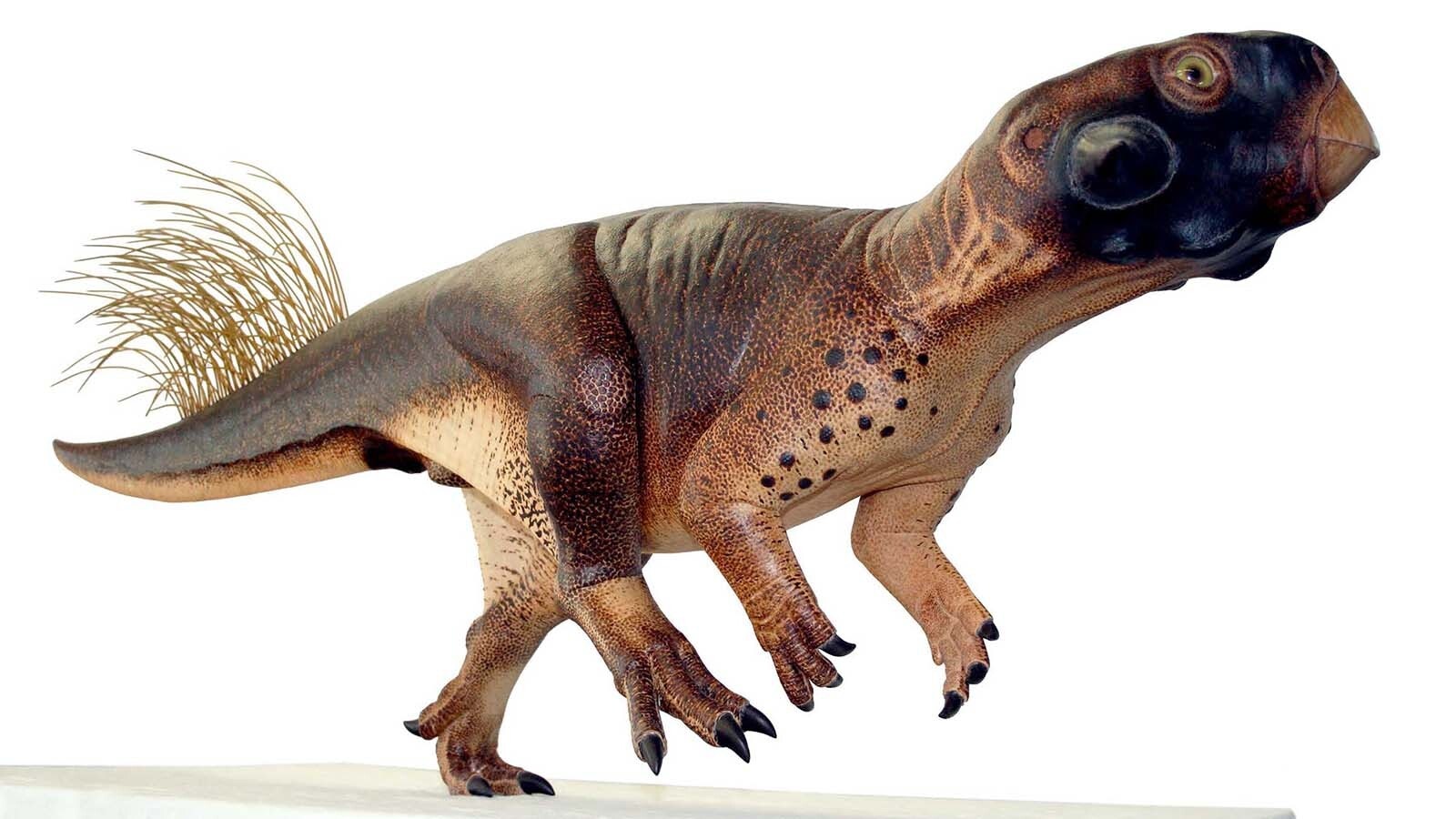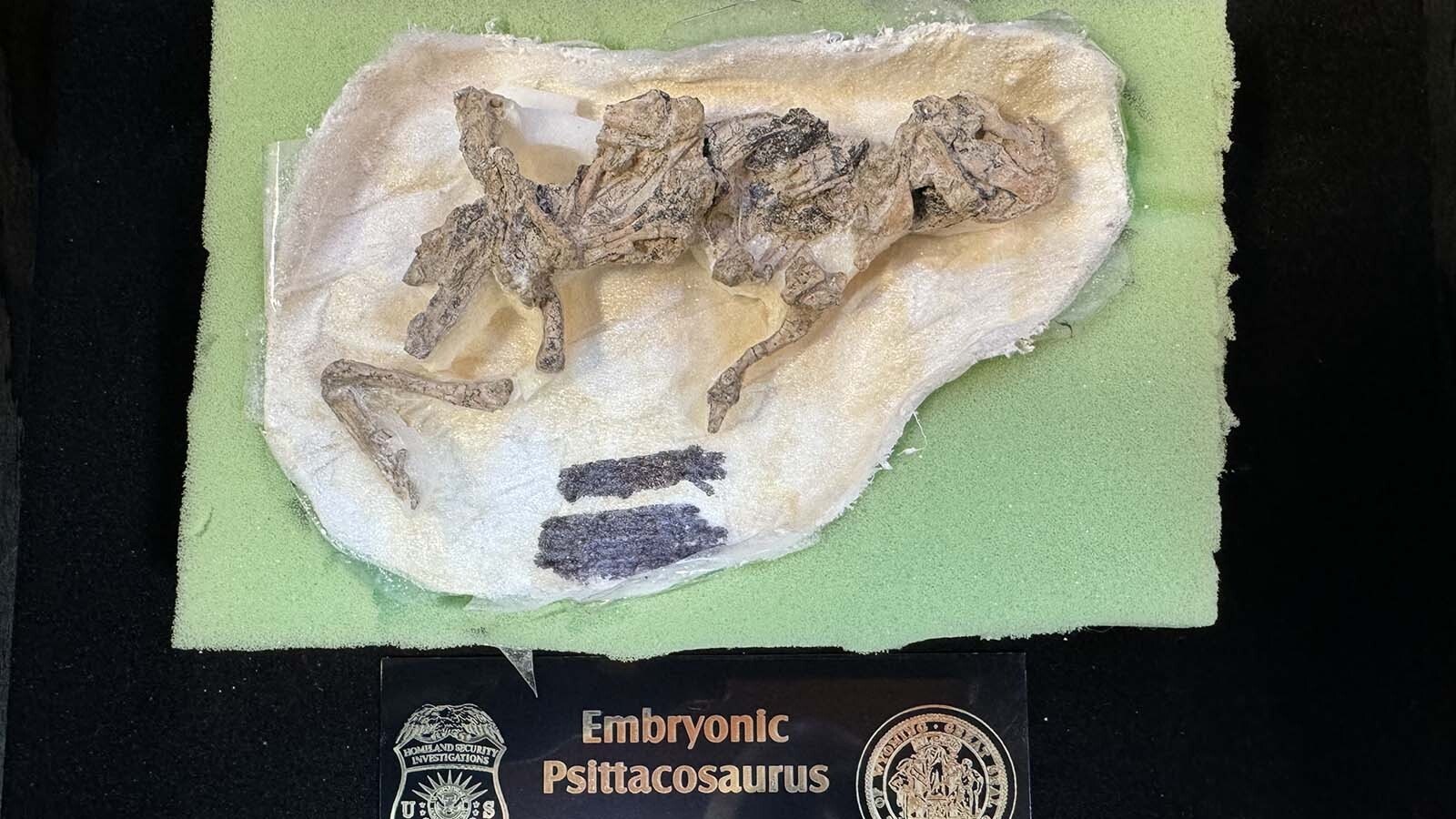The newest addition to the extensive fossil collections of the Tate Geological Museum at Casper College was discovered in eastern Asia that traveled thousands of miles to get to Wyoming and evidence in a massive federal investigation.
Travis Starr, resident agent in charge of the U.S. Department of Homeland Security Investigations Casper office, has formally donated a fossil to the Tate Geological Museum. The tiny fossil is the skeleton of a hatchling Psittacosaurus that lived more than 100 million years ago in central Asia.
While the fossilized shrivel of prehistoric baby isn’t much to look at now, extrapolations of what it could’ve looked like when alive makes it about the cutest dinosaur ever.
Psittacosaurus is a relative of Wyoming’s state dinosaur, Triceratops. Already a smaller type of dinosaur with a maximum length of 6 feet, the Tate’s Psittacosaurus is so small it could be embryonic.
“This is pretty cool,” said J.P. Cavigelli, the museum’s collections specialist. “I mean, I've been to Mongolia, but you just don't see these things too often.”
What the tiny fossil lacks in size, it more than makes up for in importance. It was evidence in a multi-year investigation that uncovered an international fossil trafficking network.
The conclusion was a diplomatic win for the United States, and a unique fossil for Casper.
Missing Mongolian Fossils
Homeland Security Investigations (HSI) is the investigative component of the U.S. Department of Homeland Security. Around 1,600 special agents stationed throughout the nation and 200 agents internationally investigate international criminal organizations that try to exploit global infrastructure, trade, travel and finance.
“We investigate cross-border movements of contraband,” Starr said. “That can be people, commodities or money. That’s the short of it.”
Starr explained that the investigation that brought the tiny Psittacosaurus to the Tate Geological Museum started in 2012 when an HSI agent in Casper got a tip about a Mongolian dinosaur skull in a Wyoming rock shop.
“An individual reported that there was a retail store in Wyoming selling a fossilized (Tarbosaurus) skull that was imported contrary to U.S. law,” Starr said. “And at an auction somewhere else in the United States, they were selling a full fossil skeleton of a Tarbosaurus, and the Mongolian government was contesting it.”
Between 2012 and 2019, agents followed leads and prosecuted those responsible for smuggling fossils from Mongolia and China into the United States. Starr said their work uncovered “an illicit global network of traffickers” operating in France, Japan, Germany, Canada and several other places.
“Our agents were able to recover 63 fossils of Chinese origin, worth approximately $1.5 million,” he said, “and 18 fossils of Mongolian origin valued over $6 million. So, you can see why there’s a global network of traffickers. There’s value in it.”
In August 2023, a repatriation ceremony was held at the Library of Congress in Washington, D.C., to return all the illicitly smuggled Mongolian fossils to the Mongolian people, including the Tarbosaurus skull found in the Wyoming rock shop.
Starr said some people were prosecuted as part of the investigation, and a handful of culprits were prosecuted multiple times as they continued dealing in smuggled fossils. However, prosecution was not the primary objective.
“The philosophy on cultural property, arts and antiquities investigations is the actual recovery of the artifact, not prosecution,” he said. “Repatriating it back to its country of origin is important to that country's cultural identity and ethnic heritage.”

All Except One
When presented with the opportunity to repatriate dozens of its fossils, the Mongolian government eagerly agreed to take nearly all of them. Except for one.
For whatever reason, the Mongolian government declined to repatriate the tiny Psittacosaurus skeleton. Starr said it was sitting in a government warehouse in Casper until HSI decided to find a better home for the foreign fossil.
“One of the agents had the idea: Why keep it in the warehouse? Why don't we donate it to the museum so people can see it? And that seemed like the best outcome,” Starr said.
The Tate Geological Museum wasn’t selected simply because it’s in Casper. The Tate is a federal fossil repository, a permanent home for fossils collected on federal land. Since the Psittacosaurus technically became a federal fossil, the Tate was a perfect place to put it.
There’s a global effort for museums to return any Mongolian fossils in their collections to the Mongolian government. It’s rare for any museum to have a Mongolian fossil, permanently and legally, in its collection.
“We're proud to be a repository for it,” said Dalene Hodnett, director of the Tate Geological Museum. “It’s unique to have something like that in Wyoming. It speaks to the reputation of the Tate as a community partner and a research institution.”
The tiny fossil isn’t on display yet. The museum’s in-house educator and artist, Russell Hawley, is working on a display that will include a drawing of what the Psittacosaurus would’ve looked like when it was alive.
“Hawley’s going to make a beautiful drawing because he only makes beautiful drawings,” Cavigelli said. “He's going to make a drawing of this thing so we can interpret it for the public to see. When they look at (the fossil), they say, ‘I don't see much.’ But when they look at Russel’s drawing, they'll say, ‘Ah ha! That's cool.’”

Andrew Rossi can be reached at arossi@cowboystatedaily.com.





